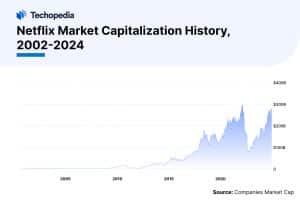Netflix (NFLX) stands as a major player in the streaming industry. With its extensive content library and 270 million global subscriber base, the company has transformed how we enjoy entertainment.
Since its beginnings as a DVD rental service in 1997, the company has evolved into a leading streaming service that offers original content as well as an extensive library of licensed shows and films available on demand.
At the center of Netflix’s success is its innovative business model, which generates revenue through a combination of subscription fees, strategic investments in content, and sophisticated data analytics.
So, how does Netflix make money? In this article, we explore the various Netflix revenue streams and financial strategies that have positioned it as a dominant player in digital entertainment.
Key Takeaways
- Netflix’s business model is based on a subscription service where users pay monthly fees to access a massive library of movies, TV shows, and original content.
- Netflix’s top revenue streams primarily come from subscription fees, content licensing, and original content production.
- Netflix’s annual revenue for 2023 was $33.723 billion, up 6.67% from 2022.
- Netflix has over 270 million paid subscribers.
- In 2023, Netflix members watched 183 billion hours of Netflix.
Netflix’s Business Model
Netflix’s business model is based on a subscription service where users pay monthly fees to access a massive library of movies, TV shows, and original content.
The company also generates revenue from content licensing, partnerships, merchandise sales, and ad-supported plans. This model relies on continually expanding its subscriber base and producing or acquiring compelling content to keep viewers engaged.
Netflix’s Financials
How much money does Netflix make a year?
Netflix’s annual revenue for 2023 was $33.723 billion, up 6.67% from 2022. For the quarter ending March 31, 2024, Netflix’s revenue was $9.370 billion, up 14.81% year-over-year. And Netflix’s annual revenue for the 12 months ending March 31, 2024 was $34.932 billion, up 9.47% year-over-year.
Netflix’s annual net income for 2023 was $5.408 billion, up 20.39% from 2022. And Netflix’s income for the 12 months ending March 31, 2024 was $6.435 billion, up 53.23% year-over-year.
Top Revenue Streams
Netflix’s top revenue streams primarily come from subscription fees, content licensing, and original content production.
The largest portion of its revenue is generated through subscription fees paid by millions of subscribers worldwide.
If you wonder how many subscribers does Netflix have? Netflix has more than 270 million paid subscribers. In 2023, Netflix members watched 183 billion hours of Netflix.

The subscription fees are based on different pricing tiers that offer various features and video quality.
How does Netflix make money on movies? The company uses the money it gets from its subscribers to buy the streaming rights for a film and also to produce its own content.
Netflix also earns substantial revenue from licensing agreements, allowing it to stream movies and TV shows produced by other studios while also licensing its original content to other platforms.
In addition, its original content production is a significant revenue stream for Netflix, as its original shows and movies enable the company to attract and retain subscribers, further increasing its subscriber base.
Greg Peters, co-CEO of Netflix, said in a recent blogpost:
“People often ask why we make so many shows and movies? Do we really need them all? All the evidence we have suggests the answer is ‘yes.’ To satisfy our audience of over half a billion people, we need lots of great stories that appeal to lots of different tastes.”
Netflix Future Growth Plans
International Expansion
The future for Netflix involves several key areas. For one thing, the company will continue to invest in producing original content, such as movies, TV shows, and documentaries, to set itself apart from competitors and attract new subscribers.
Netflix is also planning to continue its global expansion. The company aims to penetrate further into international markets by creating and acquiring content tailored to local tastes and preferences, which will help attract and retain subscribers worldwide.
In-House Advertising Platform
Advances in streaming technology, user interface improvements, and personalized recommendations will enhance user experience and help retain subscribers.
By the end of 2025, Netflix will roll out an in-house advertising technology platform. This platform will provide advertisers with new purchasing options, enhanced insights, and improved ways to measure the impact of their ads.
Diversification
Netflix is also diversifying into new entertainment sectors, such as gaming, live events, and interactive content, broadening its appeal and revenue sources.
For example, the National Football League is coming to Netflix. The company will be streaming the NFL’s two Christmas Day games this year and at least one Christmas Day game in 2025 and 2026.
The First Netflix House
In 2025, the company also plans to launch the first Netflix House, a “flagship store where fans can get closer to the stories and stars they love with food, retail, and experiences that change throughout the year.”
Partnerships
Additionally, new and ongoing partnerships with telecom companies, such as Deutsche Telekom, device manufacturers, and content creators, will enable Netflix to expand its reach and enhance its content library. By focusing on these areas, Netflix aims to sustain its growth, stay competitive, and continue leading the streaming industry.
The Dark Side of Netflix: Controversies & Criticism
Netflix has faced several controversies and criticisms over the years that reflect the complexities of its position as a leading global entertainment provider. One major issue is the content it chooses to produce and stream. Some viewers and critics maintain that certain shows and movies are inappropriate, offensive, or culturally insensitive.
For example, some have accused Netflix of misrepresenting or exploiting sensitive topics in its original productions for entertainment purposes. Additionally, some people have criticized Netflix for its portrayal of historical events and figures, calling out inaccuracies and bias.
The company’s data-driven approach to content creation has also been criticized. Critics contend that relying heavily on algorithms and viewer data may prioritize popular, predictable content over more innovative or artistically ambitious projects.
And Netflix’s practice of releasing entire seasons of shows at once has sparked debate about its impact on traditional television viewing habits. While some appreciate the convenience, others raise concerns about the potential for unhealthy binge-watching behavior, which can affect viewers’ mental health and social lives.
Moreover, Netflix has faced scrutiny over its impact on the broader entertainment industry. Its dominance in the streaming market has raised concerns about how smaller production companies and independent filmmakers can compete.
The shift toward streaming has also affected traditional movie theaters as fewer people are attending movies in theaters in favor of watching them at home. Additionally, the company’s aggressive global expansion has sometimes resulted in conflicts with cultural norms and local content regulations, complicating its international strategy.
These controversies highlight the challenges Netflix faces as it continues to grow and evolve. Balancing commercial success with social responsibility, artistic integrity, and cultural sensitivity remains a complex task for the streaming giant.
Competitors
Netflix’s competitors include traditional streaming behemoths, such as HBO Max, Hulu, Disney+, and Amazon Prime Video.
In addition, newer players and less direct competitors are also challenging Netflix. For example, Peacock and Apple TV+ are emerging as contenders, while YouTube and social media platforms present indirect competition.
The Bottom Line
Netflix’s financial success stems from a business model that’s centered around subscription fees, content licensing, and producing original content. By continually expanding its global subscriber base, investing in diverse and high-quality original programming, and exploring new revenue streams, Netflix has positioned itself as a leader in the streaming industry.
As the company navigates evolving market dynamics and increasing competition, its ability to innovate and adapt will be critical for sustaining profitability and growth in the years ahead.
FAQs
How does Netflix make a profit?
Does Netflix make a net profit?
Does Netflix make or lose money?
How do Netflix shows earn money?
References
- Netflix Revenue 2010-2024 | NFLX | MacroTrends (Macrotrends)
- Netflix (NFLX) – Revenue (Companiesmarketcap)
- Netflix Upfront 2024: The Year of Growth and Momentum – About Netflix (About.netflix)
- Netflix Will Spend More on International Markets Than Stateside for the First Time » FilmTake (Filmtake)
- NFL Games Are Coming to Netflix Christmas 2024 – Netflix Tudum (Netflix)
- Greg Peters Keynote: Deloitte and Enders Analysis Media & Telecoms 2024 and Beyond Conference – About Netflix (About.netflix)
- Deutsche Telekom expands partnership with Netflix | Deutsche Telekom (Telekom)
- A Historian’s Rant about Netflix’ ‘Roman Empire’ (Tl)
- Streaming Service Algorithms are Biased, Directly Affecting Content Development — AMT Lab @ CMU (Amt-lab)
- Do you think Netflix’s approach to releasing entire seasons of series at once for binge-watching is beneficial for viewers? Why or why not? – Quora (Quora)
- A New Studio Era: How Netflix is Becoming a Threat to the Film Industry (Pdxscholar.library.pdx)
- Impact of Streaming on Cinema Attendance (Filmgrail)
- International Expansion: Netflix, Amazon & Microsoft | Velocity Global (Velocityglobal)








